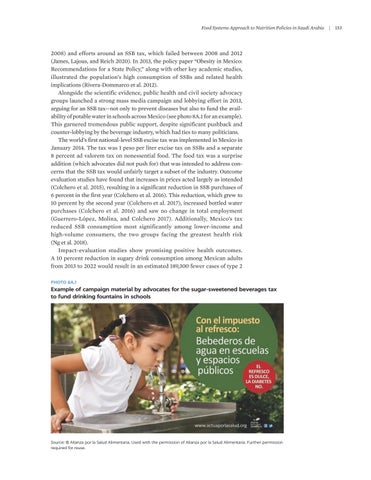Food Systems Approach to Nutrition Policies in Saudi Arabia
2008) and efforts around an SSB tax, which failed between 2008 and 2012 (James, Lajous, and Reich 2020). In 2013, the policy paper “Obesity in Mexico: Recommendations for a State Policy,” along with other key academic studies, illustrated the population’s high consumption of SSBs and related health implications (Rivera-Dommarco et al. 2012). Alongside the scientific evidence, public health and civil society advocacy groups launched a strong mass media campaign and lobbying effort in 2013, arguing for an SSB tax—not only to prevent diseases but also to fund the availability of potable water in schools across Mexico (see photo 8A.1 for an example). This garnered tremendous public support, despite significant pushback and counter-lobbying by the beverage industry, which had ties to many politicians. The world’s first national-level SSB excise tax was implemented in Mexico in January 2014. The tax was 1 peso per liter excise tax on SSBs and a separate 8 percent ad valorem tax on nonessential food. The food tax was a surprise addition (which advocates did not push for) that was intended to address concerns that the SSB tax would unfairly target a subset of the industry. Outcome evaluation studies have found that increases in prices acted largely as intended (Colchero et al. 2015), resulting in a significant reduction in SSB purchases of 6 percent in the first year (Colchero et al. 2016). This reduction, which grew to 10 percent by the second year (Colchero et al. 2017), increased bottled water purchases (Colchero et al. 2016) and saw no change in total employment (Guerrero-López, Molina, and Colchero 2017). Additionally, Mexico’s tax reduced SSB consumption most significantly among lower-income and high-volume consumers, the two groups facing the greatest health risk (Ng et al. 2018). Impact-evaluation studies show promising positive health outcomes. A 10 percent reduction in sugary drink consumption among Mexican adults from 2013 to 2022 would result in an estimated 189,300 fewer cases of type 2 PHOTO 8A.1
Example of campaign material by advocates for the sugar-sweetened beverages tax to fund drinking fountains in schools
Source: © Alianza por la Salud Alimentaria. Used with the permission of Alianza por la Salud Alimentaria. Further permission required for reuse.
|
153






